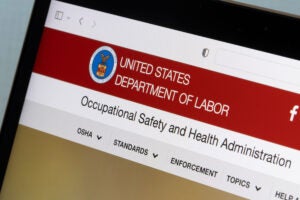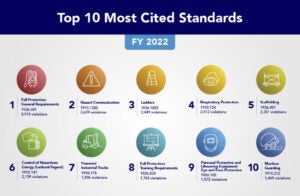The Occupational Safety and Health Administration (OSHA) feels like the boogeyman of agriculture — everybody knows about it, some are afraid of it, and we all check under the bed for it now and again.
One of my jobs on the dairy farm is safety management. When I first started thinking about farm safety, I had to ask myself what OSHA really is, and I can tell you that OSHA isn’t as scary as many make the agency out to be.
OSHA was born from the Occupational Safety and Health Act of 1970, and its purpose is to “ensure safe and healthful working conditions for workers by setting and enforcing standards and by providing training, outreach, education and assistance,” according to its mission statement.
OSHA covers most private employers in the U.S. and overseen by the Secretary of Labor for Occupational Safety and Health. There are regional offices located in most states to help you with all your OSHA needs!

But what does it mean to be regulated by OSHA?
You can think of OSHA like an inspection on your car. In order to put a car on the road, it needs to be inspected, but I could drive a car around with no inspection without a problem until I got caught. You could be managing an agricultural business without following any OSHA guidelines and not realize it, but you’ll be in hot water when OSHA finds out. Which isn’t to say that you should ignore regulations just because you might get away with it — OSHA regulations are helpful for keeping employees safe and healthy at work, just like your car inspection is meant to keep you and others safe on the road.
OSHA regulations include required posters such as the Job Safety and Health poster, and general safety and health hazards.
Think about the most common causes of injury you have around the farm, probably trips over hoses, pinched fingers, bruised toes from dropping things, maybe a chemical splash in the eye.
These are all common injuries that are usually avoidable. How many injuries on the farm were a “live and learn” situation where you don’t realize something is a hazard until you hurt yourself? OSHA believes that employers need to proactively train employees so that these injuries don’t happen.
Check out OSHA’s top 10 most cited standards. How many would they ding you for on your farm?

Back to your car inspection, when you get pulled over for being out of inspection, what happens? You have to get your car inspected and you have to fix it, otherwise you will get pulled over again. After getting pulled over a few times your insurance will likely be suspended.
If you are not following OSHA regulations and something happens because of that, you’re in for an OSHA inspection, and you’re going to both pay for it and fix it.
OSHA requires that businesses report three types of accidents to them, loss of an eye, finger or limb, death of an employee at work, or a work related injury that requires hospitalization. In the event of any of these incidents, you must call OSHA to let them know what happened, and you will likely end up with an inspection.
When OSHA inspects your worksite because of an accident, they aren’t allowed to inspect anywhere except for the site of the accident unless there is an obvious and imminent danger present elsewhere.
Traditionally OSHA was not allowed to inspect a farm without a reason, but OSHA has an ever-growing program called the Local Emphasis Program (LEP) where money was funneled to OSHA in order to do pointed, random audits in different workplaces.
You can find the list of current LEP programs in place on OSHA’s website. OSHA collects injury records from all required businesses, and analyzes them to create the LEP programs.
If you look at the Kansas LEP for grain handling facilities, the background on page six explains that from 2015 to 2019, one office received an average of 45 serious reportable injuries a year from grain handling facilities alone, 25 percent of which ended in amputations or overnight stays in the hospital. When looking closer, many facilities had repeat injuries, and inspectors found over one hundred safety violations.
When trends like this happen, OSHA steps in. OSHA is here to regulate the problems, not to be a pain in your butt just for fun!
The OSHA website has lots of information on rules and regulations, as well as standards for safety and training for many aspects of ag businesses. Oftentimes when I am planning a training, I Google “OSHA standards for …” and something pops up, whether it’s a list of bullet points I need to hit, or resources I can use in training.
OSHA may be scary if their people have to show up on your doorstep, but generally speaking, you shouldn’t fear them, nor should you ignore their rules! Although some things seem silly or inconvenient, keeping your employees safe and healthy on the farm is important, and most accidents are preventable, it’s just up to you to prevent them!
Check out OSHA’s resources on their top 10 most cited standards, and definitely take a look through their training resources library.
As an ag business owner, you are the only one able to keep OSHA from coming to your farm, so be proactive, and keep your employees safe and healthy at work!
Elizabeth Maslyn is a born-and-raised dairy farmer from Upstate New York. Her passion for agriculture has driven her to share the stories of farmers with all consumers, and promote agriculture in everything she does. She works hard to increase food literacy in her community, and wants to share the stories of her local farmers.



